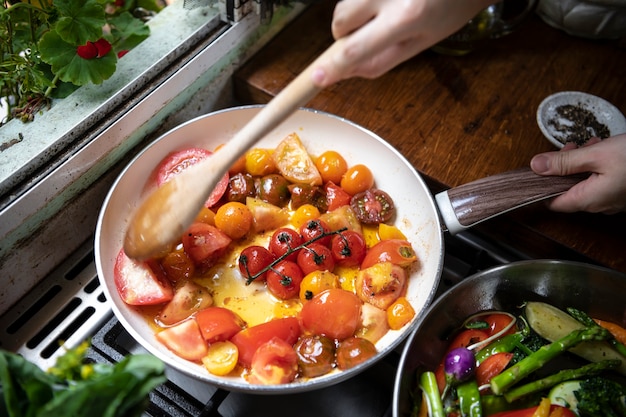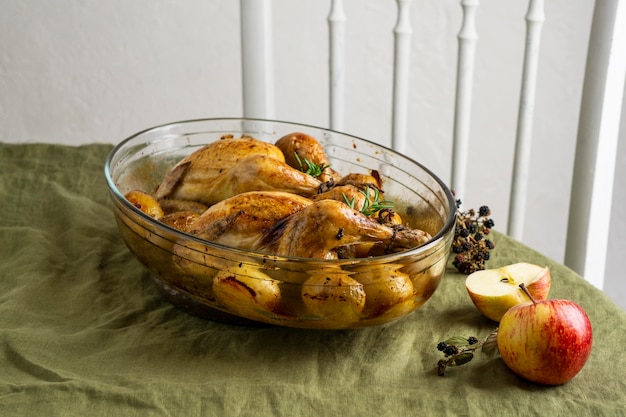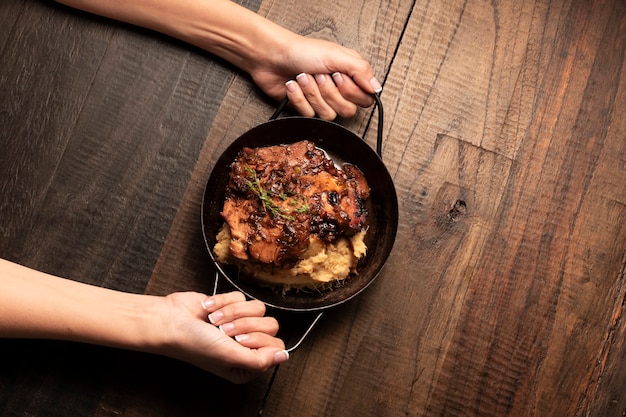The comforting aroma of slow-cooked chicken, the tender, fall-off-the-bone texture – there’s something truly magical about a crockpot meal. But let's be honest, one question always lingers: how long do you cook chicken on high in a crockpot to get those perfect results? It’s not just about throwing chicken in and hoping for the best, it’s about understanding the process and mastering the art of slow-cooking.
Over the years, I've become a bit of a crockpot aficionado, experimenting with countless recipes and techniques. I've learned a thing or two about achieving that melt-in-your-mouth tenderness with crockpot chicken. So, join me as we delve into the world of slow-cooked poultry and uncover the secrets to creating a delicious, juicy, and perfectly cooked meal every time.
Part 1: Understanding the Basics

Before we dive into specific cook times, let’s lay the foundation for success. It’s all about understanding the science behind slow-cooking and the factors that influence how long it takes to reach that coveted point of perfect tenderness.
The Importance of Temperature: A Crucial Factor
Think of your crockpot as a gentle, low-and-slow oven. It gradually heats the chicken, creating a symphony of flavors and textures as the meat breaks down, becoming incredibly tender and flavorful. But the real magic happens when the chicken reaches a safe internal temperature of 165°F (74°C). This is the minimum temperature required to destroy harmful bacteria, ensuring a delicious and safe meal.
Factors Affecting cooking time: More Than Just a Number
Cooking time for chicken on high in a crockpot isn't just a fixed number. It’s a dynamic process that varies depending on several key factors:
- Size Matters: Smaller pieces, like chicken breasts or tenders, will cook faster than larger pieces, like whole chicken thighs or drumsticks. Think of it like trying to heat a small pan versus a large one – the smaller pan heats up quicker.
- Thickness Matters: Thicker pieces of chicken require more time to cook through compared to thinner pieces. Heat needs to penetrate the entire piece of meat to reach that safe internal temperature.
- Quantity Counts: More chicken means a longer cooking time, as the crockpot needs to heat up the entire mass of meat to the desired temperature. It's similar to how a pot of water takes longer to boil with more water in it.
- Crockpot Capacity: A smaller crockpot will heat up faster than a larger one, affecting the cooking time. A smaller container means less space for the heat to disperse, resulting in faster cooking.
Part 2: The Crockpot Chicken High-Cooking Time Guide: Your Recipe Roadmap

Now, let's get down to the nitty-gritty of cooking times. This guide is based on my extensive experimentation and countless crockpot adventures. Remember, always use a meat thermometer to verify the chicken has reached a safe internal temperature before serving.
Chicken Breasts: Tender and Juicy
For those succulent and juicy chicken breasts, here’s your time frame:
- 1-2 pounds of boneless, skinless chicken breasts: 2-3 hours on high
- 3-4 pounds of boneless, skinless chicken breasts: 3-4 hours on high
chicken thighs: The More Forgiving Cut
Chicken thighs are more forgiving than breasts and can handle longer cooking times, resulting in incredibly tender meat. Here’s how long to cook your thighs:
- 1-2 pounds of bone-in chicken thighs: 3-4 hours on high
- 3-4 pounds of bone-in chicken thighs: 4-5 hours on high
Whole Chicken: A Feast Worthy of Patience
Cooking a whole chicken in the crockpot is a true testament to slow cooking. While it might take a bit longer, the results are well worth the wait. For a whole chicken weighing around 3-4 pounds, you can expect:
- Cooking time: 4-5 hours on high
Remember, these are just starting points. Always check the internal temperature of the chicken with a meat thermometer before serving.
Part 3: Beyond the Time: Essential Tips for Success

Now that we've laid the groundwork for cooking times, let’s explore some key tips that will elevate your crockpot chicken game. It’s about creating the perfect environment for those flavors to mingle and that tender texture to develop.
1. Don't Overcrowd the Crockpot: Giving Chicken Room to Breathe
Just like a crowded pan, overcrowding the crockpot hinders proper heat distribution. Imagine trying to cook a meal in a pan that’s overflowing. It’s impossible to get everything cooked evenly. The same principle applies to your crockpot. Aim for a single layer of chicken pieces to allow for adequate circulation and even heat. If you have a large quantity of chicken, you may need to cook in batches to ensure everything cooks properly.
2. Seasoning is Key: Flavorful Magic
Don’t underestimate the power of seasoning. A well-seasoned chicken is a symphony of flavors that will tantalize your taste buds. A simple combination of salt, pepper, garlic powder, and onion powder is a great starting point. But don't be afraid to get creative! Herbs, spices, and sauces can add depth and complexity to your chicken. Think about the flavor profiles you enjoy – whether it’s a Mediterranean blend, a tangy citrus zest, or a smoky paprika rub – and let your imagination guide you.
3. Add Liquids for Moistness: Keeping Chicken Tender and Delicious
Chicken can dry out if cooked too long without moisture. This is where the liquid magic comes in! Add about 1 cup of liquid to the crockpot, such as chicken broth, water, or even a combination of both. The liquid will not only help keep the chicken moist and flavorful but will also create a delicious sauce to baste the chicken as it cooks. You can also add aromatics like onions, garlic, and herbs to the liquid to infuse the chicken with incredible flavor.
Part 4: The Art of Deglazing: Unlocking Hidden Flavor
Have you ever noticed that delicious brown residue stuck to the bottom of your crockpot after cooking? That’s not just burnt bits; it’s a flavor bomb waiting to be released! This magical process is called deglazing, and it’s a simple technique that takes your crockpot chicken from good to phenomenal. Here’s how it works:
- Remove the Chicken: Once the chicken is cooked, carefully remove it from the crockpot and set it aside.
- Add Liquid: Pour about a cup of liquid (like chicken broth or wine) into the crockpot.
- Scrape the Bottom: Using a wooden spoon, scrape the bottom of the crockpot to loosen the browned bits.
- Simmer: Bring the liquid to a simmer and let it cook for a few minutes, allowing the flavor to meld and create a rich, flavorful sauce.
- Return the Chicken: Once the liquid has reduced slightly, return the chicken to the crockpot, allowing it to soak up all that delicious goodness.
This simple step will transform your ordinary crockpot chicken into a culinary masterpiece, creating a rich, flavorful sauce that perfectly complements your cooked chicken.
Part 5: Crockpot chicken recipes: Beyond the Basics
While the basic concept of cooking chicken in a crockpot is straightforward, the possibilities for flavor combinations are truly endless. Here are a few of my favorite recipes to inspire your culinary adventures.
1. Crockpot Buffalo Chicken: A Crowd-Pleasing Classic
This is a game day staple that's perfect for casual gatherings or a quick and easy dinner. Simply toss the chicken with buffalo sauce and cream cheese in the crockpot and cook until heated through. Serve on buns with your favorite toppings like celery sticks, blue cheese crumbles, and a drizzle of ranch dressing.
2. Crockpot Chicken and wild rice soup: Cozy Comfort in a Bowl
For a cozy and comforting meal, try this hearty soup. Combine chicken, wild rice, broth, vegetables like carrots, celery, and onions, and seasonings like thyme and bay leaves in the crockpot and cook until the rice is tender. It’s the perfect comfort food for a chilly evening.
3. Crockpot BBQ Chicken: A Flavorful Favorite
This recipe is a classic for a reason. Combine chicken with your favorite bbq sauce – whether it’s sweet and smoky, tangy, or spicy – and cook until tender. Serve on buns, over rice, or with a side of coleslaw.
Part 6: Crockpot Chicken on High: Troubleshooting Common Issues
Even the most seasoned cooks encounter bumps in the road sometimes. Here are a few common issues you might face when cooking chicken on high in a crockpot, along with some troubleshooting tips:
1. Dry Chicken: Restoring Moisture to Your Meal
If your chicken turns out dry, it’s likely that it was cooked for too long or didn’t have enough moisture. To prevent this, ensure you’re following the recommended cooking times and always add enough liquid to the crockpot. You can also try adding a bit of butter or cream to the crockpot during the last hour of cooking to help keep the chicken moist. The fat will melt and create a delicious, velvety sauce.
2. Uneven Cooking: Ensuring Consistency
If you find that some parts of the chicken are cooked through while others are still raw, it could be due to overcrowding the crockpot or not stirring the chicken regularly. To avoid this, cook chicken in batches if necessary, and make sure to stir the chicken occasionally throughout the cooking process.
Part 7: Tips for Storing and Reheating Leftovers: Making the Most of Your Meal
Let's face it, we often end up with leftover crockpot chicken. Storing and reheating leftovers properly is key to keeping the delicious flavors and tenderness intact. Here’s what you need to know:
Storage: Keeping Your Leftovers Fresh and Flavorful
Allow the chicken to cool completely before transferring it to an airtight container. Refrigerate the leftovers for up to 3-4 days.
Reheating: Restoring the Magic
You can reheat leftovers in the microwave or in the oven. For the microwave, reheat in short bursts, stirring occasionally to ensure even heating. For the oven, preheat to 350°F (175°C) and bake for 15-20 minutes until heated through. If you have a little time, consider adding a bit of liquid to the crockpot and simmering the leftovers to restore their moisture and flavor.
Part 8: FAQs: Answers to Your Burning Questions
Here are answers to some common questions about cooking chicken on high in a crockpot:
1. Can I cook chicken on high for more than the recommended time?
While it’s technically possible to cook chicken on high for longer than the recommended time, it increases the risk of overcooking and drying out the meat. It’s always better to stick to the recommended time and check the internal temperature of the chicken to ensure it’s cooked through. Remember, overcooked chicken loses its juicy tenderness and can become dry and rubbery.
2. Can I cook frozen chicken in the crockpot?
It’s best to avoid cooking frozen chicken in the crockpot. The chicken will take longer to cook, and it’s more likely to be unevenly cooked. It’s always best to thaw the chicken thoroughly before cooking. This ensures even cooking and prevents the risk of foodborne illness.
3. Can I use a meat thermometer to check the temperature of the chicken in the crockpot?
Absolutely! Using a meat thermometer is the best way to ensure that your chicken is cooked to a safe internal temperature of 165°F (74°C). Insert the thermometer into the thickest part of the chicken, avoiding any bones. This will give you an accurate reading and ensure your chicken is cooked through.
4. Is it safe to leave the crockpot on high overnight?
It’s not recommended to leave the crockpot on high overnight. The chicken could be overcooked and dry, and leaving a heating appliance unattended for an extended period poses a safety risk. If you need to cook chicken overnight, it’s best to switch the crockpot to the low setting. The low setting provides a gentler heat and helps prevent overcooking.
5. What are some of the best crockpot chicken recipes?
There are countless amazing crockpot chicken recipes available online and in cookbooks. Some popular options include: Crockpot Chicken Fajitas (a flavorful and easy weeknight meal), Crockpot Chicken Parmesan (a classic comfort food with a twist), Crockpot Chicken Enchiladas (a delicious and satisfying dish), and Crockpot Chicken and Dumplings (a warm and comforting option).
Part 9: Conclusion: Crockpot Chicken on High: Embrace the Simplicity
Cooking chicken on high in a crockpot is a game changer for busy weeknights. It’s a simple and versatile method that allows you to create a variety of flavorful and satisfying meals. By understanding the basics of cooking time, incorporating helpful tips, and embracing the art of deglazing, you’ll be well on your way to mastering this convenient cooking technique. So, next time you’re craving a delicious and effortless meal, fire up your crockpot and let the aromas of slow-cooked chicken fill your home.
Everyone is watching

Corn on the Cob: The Ultimate Guide to Perfectly Cooked Ears
Healthy MealsAh, corn on the cob. Just the name evokes images of sunny days, barbecues, and that sweet, juicy flavour that ...

Scallops: The Ultimate Guide to Perfect Cooking
Healthy MealsAh, scallops. Those delicate, sweet, and utterly delicious morsels of the sea. They hold a special place in my...

Spaghetti Squash: The Ultimate Guide to Cooking and Serving
Healthy MealsRemember that time you saw spaghetti squash at the supermarket, looking all bumpy and strange, and thought, "W...

Salmon Cooking Times: Perfect Guide for Every Recipe
Healthy MealsLet me tell you, cooking salmon is an art form. It's all about getting that perfect balance: juicy and tender,...

Ham Cooking Time: How Long to Bake, Smoke, or Boil a Delicious Ham
Healthy MealsAh, ham. It's a classic, isn't it? A real crowd-pleaser, especially around holidays. And when done right, it'...
